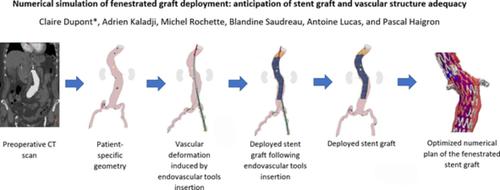当前位置:
X-MOL 学术
›
Int. J. Numer. Method. Biomed. Eng.
›
论文详情
Our official English website, www.x-mol.net, welcomes your feedback! (Note: you will need to create a separate account there.)
Numerical simulation of fenestrated graft deployment: Anticipation of stent graft and vascular structure adequacy
International Journal for Numerical Methods in Biomedical Engineering ( IF 2.1 ) Pub Date : 2020-10-24 , DOI: 10.1002/cnm.3409 Claire Dupont 1 , Adrien Kaladji 1 , Michel Rochette 2 , Blandine Saudreau 3 , Antoine Lucas 1 , Pascal Haigron 1
International Journal for Numerical Methods in Biomedical Engineering ( IF 2.1 ) Pub Date : 2020-10-24 , DOI: 10.1002/cnm.3409 Claire Dupont 1 , Adrien Kaladji 1 , Michel Rochette 2 , Blandine Saudreau 3 , Antoine Lucas 1 , Pascal Haigron 1
Affiliation

|
Fenestrated endovascular aneurism repair (FEVAR) is a minimally invasive technique, and its success depends on the adequacy of the correspondence between the visceral arteries ostia and position of the fenestrations of the stent graft (SG) during its deployment in juxtarenal aneurisms. However, the fenestration position is generally determined from a preoperative computerised tomography (CT) scan, without considering the vascular deformation induced by the insertion of the endovascular tools. Catheterisation difficulties may occur during clinical procedures. Accordingly, the objective of this work is to present an initial proof of concept aimed at anticipating and optimising the position of the fenestrations, while considering the vascular deformation induced by the insertion of the endovascular tools. The proposed method relies on the finite element method to simulate the SG deployment in a vascular structure (VS), and considers the vascular deformation induced by the tools. After determining the optimal simulation parameters for a patient‐specific case, the robustness of the method is demonstrated on six other representative anatomies. The simulated SG is also compared with post‐deployment CT observations, and demonstrates good adequacy. The results show that the numerically corrected fenestration positions, as determined from the simulated results following the insertion of the endovascular tools, deviate from those of the standard plan (as determined from the preoperative CT scan). This indicates that the SG–VS adequacy could be improved via simulation‐based planning, to anticipate potential catheterisation difficulties.
中文翻译:

有孔移植物部署的数值模拟:对支架移植物和血管结构充分性的预期
有孔血管内动脉瘤修复 (FEVAR) 是一种微创技术,其成功取决于内脏动脉口与支架移植物 (SG) 开窗位置之间的对应关系在其在肾旁动脉瘤中的部署过程中是否足够。然而,开窗位置通常由术前计算机断层扫描 (CT) 扫描确定,而没有考虑插入血管内工具引起的血管变形。在临床操作过程中可能会出现插管困难。因此,这项工作的目的是提出一个初步的概念证明,旨在预测和优化开窗的位置,同时考虑由插入血管内工具引起的血管变形。所提出的方法依赖于有限元方法来模拟血管结构 (VS) 中的 SG 部署,并考虑由工具引起的血管变形。在确定特定患者病例的最佳模拟参数后,该方法的稳健性在其他六个具有代表性的解剖结构上得到了证明。模拟的 SG 也与部署后的 CT 观察进行了比较,并证明了良好的充分性。结果表明,根据插入血管内工具后的模拟结果确定的数值校正开窗位置与标准计划(根据术前 CT 扫描确定)的位置不同。这表明 SG-VS 的充分性可以通过基于模拟的规划来提高,以预测潜在的导管插入困难。
更新日期:2020-10-24
中文翻译:

有孔移植物部署的数值模拟:对支架移植物和血管结构充分性的预期
有孔血管内动脉瘤修复 (FEVAR) 是一种微创技术,其成功取决于内脏动脉口与支架移植物 (SG) 开窗位置之间的对应关系在其在肾旁动脉瘤中的部署过程中是否足够。然而,开窗位置通常由术前计算机断层扫描 (CT) 扫描确定,而没有考虑插入血管内工具引起的血管变形。在临床操作过程中可能会出现插管困难。因此,这项工作的目的是提出一个初步的概念证明,旨在预测和优化开窗的位置,同时考虑由插入血管内工具引起的血管变形。所提出的方法依赖于有限元方法来模拟血管结构 (VS) 中的 SG 部署,并考虑由工具引起的血管变形。在确定特定患者病例的最佳模拟参数后,该方法的稳健性在其他六个具有代表性的解剖结构上得到了证明。模拟的 SG 也与部署后的 CT 观察进行了比较,并证明了良好的充分性。结果表明,根据插入血管内工具后的模拟结果确定的数值校正开窗位置与标准计划(根据术前 CT 扫描确定)的位置不同。这表明 SG-VS 的充分性可以通过基于模拟的规划来提高,以预测潜在的导管插入困难。


























 京公网安备 11010802027423号
京公网安备 11010802027423号